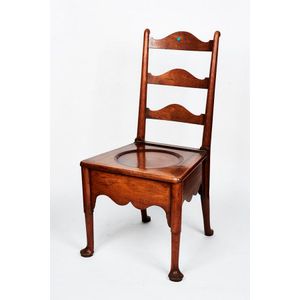Mahogany Footstool with Upholstered Seat and Sabre Legs
You must be a subscriber, and be logged in to view price and dealer details.
Subscribe Now to view actual auction price for this item
When you subscribe, you have the option of setting the currency in which to display prices to $Au, $US, $NZ or Stg.
- Proportions - Essentially, the size of the various parts of a piece of furniture in relation to the whole. Ideally, the proportions should be pleasing to the eye appearing neither top-heavy nor unbalanced and convenient for ordinary use.
- Mahogany - Mahogany is a dense, close grained red-coloured timber from the West Indies and Central America. It was first imported into Europe in the the early 18th century and its use continued through the 19th century. It was popular for furniture making because of its strength, the wide boards available, the distinctive grain on some boards, termed flame mahogany and the rich warm colour of the timber when it was polished.. The "flame" was produced where a limb grew out from the trunk of the tree, and this timber was usually sliced into veneers for feature panels on doors, backs and cornices.
Some terms used to describe mahogany relate to the country from which it originally came, such as "Cuban" mahogany, "Honduras" mahogany etc. However unless the wood has been tested the names assigned are more a selling feature, rather than a true indication of the timber's origin. - Sabre Leg - The sabre leg is commonly associated with chairs made in the Regency or classical revival manner of the early 19th century. The form was copied from designs of the ancient Grecian chair known as a klismos found on painted classical vases. The characteristic of the sabre leg is a wide, sweeping backward curve which was frequently reeded, similar to a sabre. The sweep of the front legs was sometimes complemented by a corresponding curve in the back legs of the chair, though on most domestic furniture the sweep of the rear support was not as pronounced. Sabre legs are often encountered in reproductions of the regency style. They are uncommon in Australian furniture where, by and large, colonial craftsmen preferred to use turned legs.
This item has been included into following indexes:
-
stools, type or function
- foot stools 180
- upholstered 338
Visually similar items

O. Noel Coulson (1905-1993), arm chair, c. 1958 manufactured by S. Andrewartha furniture, Melbourne, with upholstered back and seat, front legs with brass sabots. Height 85 cm, width 60 cm, depth 52 cm. Provenance: Commissioned for 211 Kooyong Rd, Toorak,

Victorian mahogany commode chair, 19th century, with ladder back and shaped apron, height 99 cm

A George III mahogany tea table, with a hinged top and polished interior, and fluted edge on square tapering legs

A George II mahogany upholstered occasional chair, English, circa 1760. Provenance: Westbury Antiques, Melbourne
